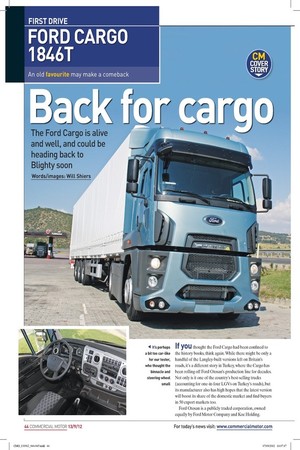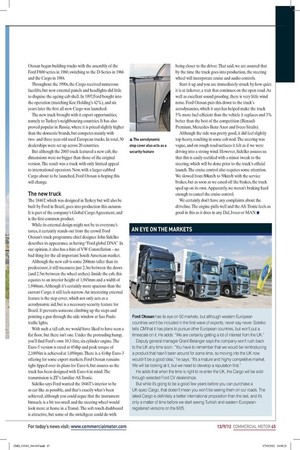Back for cargo
Page 29

Page 30

If you've noticed an error in this article please click here to report it so we can fix it.
The Ford Cargo is alive and well, and could be heading back to Blighty soon
Words/images: Will Shiers
If you thought the Ford Cargo had been confned to the history books, think again. While there might be only a handful of the Langley-built versions left on Britain’s roads, it’s a different story in Turkey, where the Cargo has been rolling off Ford Otosan’s production line for decades. Not only is it one of the country’s best-selling trucks (accounting for one-in-four LGVs on Turkey’s roads), but its manufacturer also has high hopes that the latest version will boost its share of the domestic market and fnd buyers in 50 export markets too.
Ford Otosan is a publicly traded corporation, owned equally by Ford Motor Company and Koc Holding. Otosan began building trucks with the assembly of the Ford F600 series in 1960, switching to the D-Series in 1966 and the Cargo in 1984.
Throughout the 1990s, the Cargo received numerous facelifts, but new external panels and headlights did little to disguise the ageing cab shell. In 1997, Ford bought into the operation (matching Koc Holding’s 42%), and six years later the irst all-new Cargo was launched.
The new truck brought with it export opportunities, namely to Turkey’s neighbouring countries. It has also proved popular in Russia, where it is priced slightly higher than the domestic brands, but competes mainly with twoand three-year-old used European trucks. In total, 50 dealerships were set up across 20 countries.
But although the 2003 truck featured a new cab, the dimensions were no bigger than those of the original version. The result was a truck with only limited appeal to international operators. Now, with a larger-cabbed Cargo about to be launched, Ford Otosan is hoping this will change.
The new truck
The 1846T, which was designed in Turkey but will also be built by Ford in Brazil, goes into production this autumn. It is part of the company’s Global Cargo Agreement, and is the irst common product.
While its external design might not be to everyone’s tastes, it certainly stands out from the crowd. Ford Otosan’s truck programme chief designer John Sidelko describes its appearance as having “Ford global DNA” . In our opinion, it also has a hint of VW Constellation – no bad thing for the all-important South American market.
Although the new cab is some 200mm taller than its predecessor, it still measures just 2.3m between the doors (and 2.5m between the wheel arches). Inside the cab, this equates to an interior height of 1,945mm and a width of 1,948mm. Although it’s certainly more spacious than the current Cargo, it still feels narrow. An interesting external feature is the step cover, which not only acts as a aerodynamic aid, but is a necessary security feature for Brazil. It prevents someone climbing up the steps and pointing a gun through the side window at Sao Paulo trafic lights.
With such a tall cab, we would have liked to have seen a lat loor, but there isn’t one. Under the protruding hump, you’ll ind Ford’s own 10.3-litre, six-cylinder engine. The Euro-5 version is rated at 454hp and peak torque of 2,100Nm is achieved at 1,050rpm. There is a 414hp Euro-3 offering for some export markets. Ford Otosan remains tight-lipped over its plans for Euro-6, but assures us the truck has been designed with Euro-6 in mind. The transmission is ZF’s familiar AS Tronic.
Sidelko says Ford wanted the 1846T’s interior to be as car-like as possible, and that’s exactly what’s been achieved, although you could argue that the instrument binnacle is a bit too small and the steering wheel would look more at home in a Transit. The soft-touch dashboard is attractive, but some of the switchgear could do with being closer to the driver. That said, we are assured that by the time the truck goes into production, the steering wheel will incorporate cruise and audio controls.
Start it up and you are immediately struck by how quiet it is at tickover, a trait that continues on the open road. As well as excellent sound prooing, there is very little wind noise. Ford Otosan puts this down to the truck’s aerodynamics, which it says has helped make the truck 5% more fuel-eficient than the vehicle it replaces and 3% better than the best of the competition (Renault Premium, Mercedes-Benz Axor and Iveco Stralis).
Although the ride was pretty good, it did feel slightly top-heavy, resulting in some cab nod. The steering was vague, and on rough road surfaces it felt as if we were driving into a strong wind. However, Sidelko assures us that this is easily rectiied with a minor tweak to the steering, which will be done prior to the truck’s oficial launch. The cruise control also requires some attention. We slowed from 80km/h to 50km/h with the service brakes, but as soon as we eased off the brakes, the truck sped up on its own. Apparently, we weren’t braking hard enough to cancel the cruise control.
We certainly don’t have any complaints about the driveline. The engine pulls well and the AS-Tronic feels as good in this as it does in any Daf, Iveco or MAN. ■
AN EYE ON THE MARKETS
Ford Otosan has its eye on 50 markets, but although western European countries won’t be included in the first wave of exports, never say never. Sidelko tells CM that it has plans to pursue other European countries, but won’t put a timescale on it. He adds: “We are certainly getting a lot of interest from the UK.”
Deputy general manager Grant Belanger says the company won’t rush back to the UK any time soon. “You have to remember that we would be reintroducing a product that hasn’t been around for some time, so moving into the UK now wouldn’t be a good idea,” he says. “It’s a mature and highly competitive market. We will be looking at it, but we need to develop a reputation first.” He adds that when the time is right to re-enter the UK, the Cargo will be sold through selected Ford CV dealerships.
But while it’s going to be a good few years before you can purchase a UK-spec Cargo, that doesn’t mean you won’t be seeing them on our roads. The latest Cargo is definitely a better international proposition than the last, and it’s only a matter of time before we start seeing Turkish and eastern Europeanregistered versions on the M25.




































